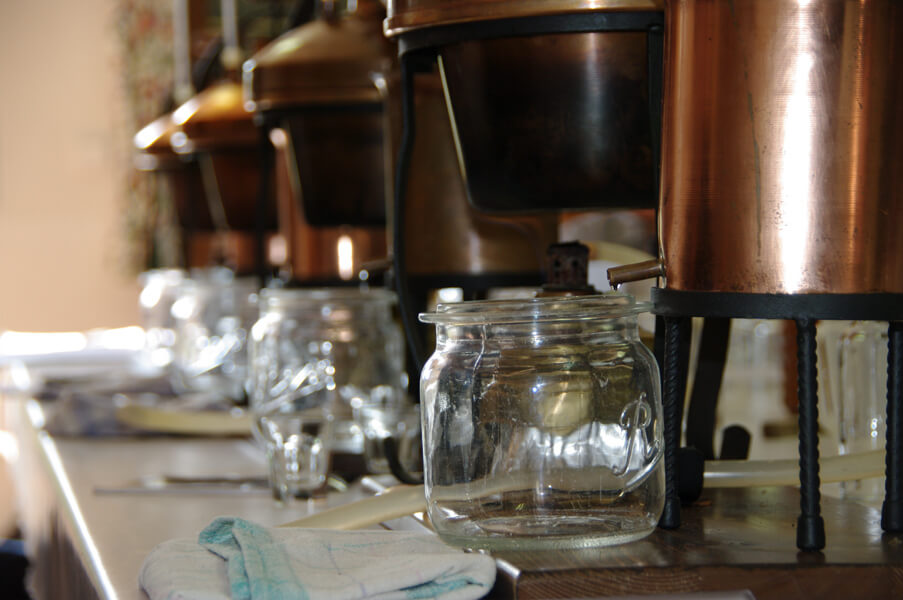A 5 Steps Beginner’s Guide for Distilled Spirits
Home distilling of alcohol is a nice hobby. But how do you make moonshine? If you want to make distilled spirits in a high quality, it is not done to put the fruit into a barrel and leave it. There is a certain quantum of basic skills necessary to make an alcoholic mash of fruit (= to mash fruits and ferment the fruit pulp) and to distill the mash (= distillation of the mash, distilling alcohol, distillation of spirits). Not till then you will rejoice in distilling alcohol at home.
Why Home Distilling of Alcohol?
There are a lot of distilled spirits found in the supermarkets. In specialist shops you can find nearly every kind of fruit distilled to spirits or brandies. So why should you spend such a lot of work on distilling alcohol at home?
- Home distilling of alcohol is a good alternative to other uses of your own fruit or to waste it.
- By reason of the small scale of distilling alcohol at home, it is possible to produce spirits which are rarely available for purchase.
- If you make your own alcohol at home by preparing your own mash, it is possible to create top quality spirits and brandies, because only by the use of small amounts of fruit it is possible to eliminate all rotten parts and stalks.
- Home distilling of alcohol is a nice hobby, which results in a lot of experiments and therefore makes a lot of fun.
Home Distilling of Alcohol – A 5 Steps Beginner’s Guide
How to make moonshine at home? Is distilling alcohol for everyone? What has to be done exactly to distill alcohol at home?
-
Legal Situation for Home Distillers
In fact there are different legal regulations in every country concerning distilling alcohol at home. So primarily contact your legal authority and inform yourself about the legal situation on home distillation at your location.
-
Fruit to Prepare the Mash
Only use clean and fully ripe fruits, which you would use for e.g. preparing a cake. It is a mistake to think that partly rotten and dirty fruit is good enough to produce alcohol in reasonable quality at home. Detailed information how to prepare the mash you find in our homemade moonshine videos, in our distillers’s guide about home distilling and in our short instruction – how do you make moonshine.
-
The Fermentation
Pour the crushed and mashed fruit into a barrel, close it, and attach a fermentation lock. The fermentation lock is essential! Don’t forget to add previously yeast, pectinase, and acid. Only with these ingredients a perfect mash will form – without mold and decay. Depending on the ingredients there are two different types of mash: conventional mashes (low alcohol content) and high-grade mashes (high alcohol content). Conventional mashes have to be distilled immediately after fermentation, for an outstanding quality the distillate has to be stored for several years in glass bottles or steel tanks (wooden cask storage is another story). High-grade mashes on the other hand should be stored for at least six months before distillation. After this period the high-grade mash is free of heads (foreshot). It’s no need to store the distillate for years to become outstanding.
-
The Distillation – Distilling Alcohol
For distillation use the entire mash, both liquid and solid parts. Don´t filter the mash before distilling. You would lose taste and smell by filtration. Therefore the stills contain solid parts. Hence it is necessary to use a burn protector. Large stills are jacketed kettles in common, mostly equipped with a stirrer, but this system is not appropriate for small copper stills of hobby distillers. If the mash contains less than about 10 %ABV alcohol, you have to distill twice (double distillation). If the alcohol content is higher than that, a simple distillation is completely sufficient. This kind of distillation produces the most intense taste and smell, more than double distilled alcohol. Don’t forget to separate the heads (foreshot). Also if your mash is free of heads, you should separate about 30 drops per 1,5 liters (1.5 US quarts) of mash. Collect the hearts until 91 °C (196 °F) steam temperature, after that you can collect the tails or stop the distillation.
-
Diluting the Distilled Spirits
There are two opposed opinions regarding alcohol dilution (alcohol dilution calculator): dilute immediately after distilling or dilute after storage. Both approaches have their specific pros and cons. We prefer to dilute immediately after distillation, in this case the finished spirit or brandy can be stored in glass bottles. Nevertheless do not dilute immediately after distillation if the spirit or brandy will be stored in wooden casks – a part of the alcohol will evaporate through the cask’s wall. In this is case dilute the brandy after storage. In other cases put the alcohol in containers (bottles) made of glass, ceramic, or stainless steel. NEVER use plastic to store high-proof alcohol!

